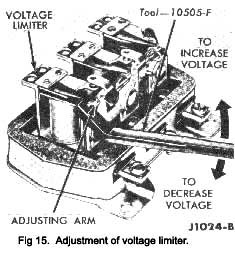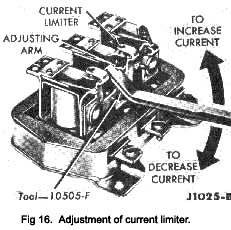To increase the voltage setting, increase the spring tension by bending the adjusting arm upwards. To decrease the voltage, bend the adjusting arm down-wards. Check the voltage setting with the regulator cover in position.
Adjusting the current limiter relay (Refer to Fig. 15)
If the current limit is less than that specified, increase the spring tension by bending the current limiter adjusting arm upwards. To decrease the current limit, bend the adjusting arm downwards, afterwards, refit the cover.
|
Voltage regulator removal
To remove and refit
Disconnect the battery negative (earth) cable.
Disconnect the armature, field and battery leads at the regulator terminals.
Remove the mounting screws and the voltage regulator.
Note—Always disconnect the battery negative (earth) cable when working on the regulator to prevent an accidental short circuit.
To refit the voltage regulator, position the unit and secure with the mounting screws. Connect the earth lead to the terminal at the rear of the regulator, connect the armature, field, battery and radio suppression capacitor (if fitted) leads to the appropriate regulator terminals and then reconnect the battery negative (earth) cable.
VOLTAGE REGULATOR AND CIRCUIT TEST
(Refer to Fig. 17)
The four tests presented here are outlined for on-the-car operation and must be conducted in the sequence indicated. Ensure that the voltage regulator is at
normal “ operating temperature (after 20 minutes of operation with the bonnet closed). Connect the test equipment as shown In Fig. 17.
Note—Always be careful when making any test connections to the regulator, so as not to short the battery lead or terminal to the regulator field. To do so will burn the regulator contacts.
Disconnect the battery negative (earth) lead whilst making these connections.
Output Test:
Start the engine and “ run” it at approximately 1500 r.p.m. Decrease the resistance in the field circuit (rotate the field rheostat clockwise) when the voltage output of the generator, indicated by the voltmeter, will increase until the cut-out closes. The cut-out closing will be indicated by a rise of the ammeter needle and a “dip” of the voltmeter needle.
The maximum voltage at the time the voltmeter needle dips or drops back, will be the closing voltage of the cut-out relay. This operation is to be repeated In order to accurately determine the closing voltage of the cut-out.
Voltage limiter test:
Rotate the field rheostat to the maximum clockwise position so as to reduce the resistance in the field circuit to zero. Rotate the centre control to the 1/4 ohm posi-tion when the ammeter should indicate an approximate 10 amp. load. Read the voltage regulation on the volt-meter scale. Speed the engine momentarily to see if the voltage remains regulated.
|
 **
**

